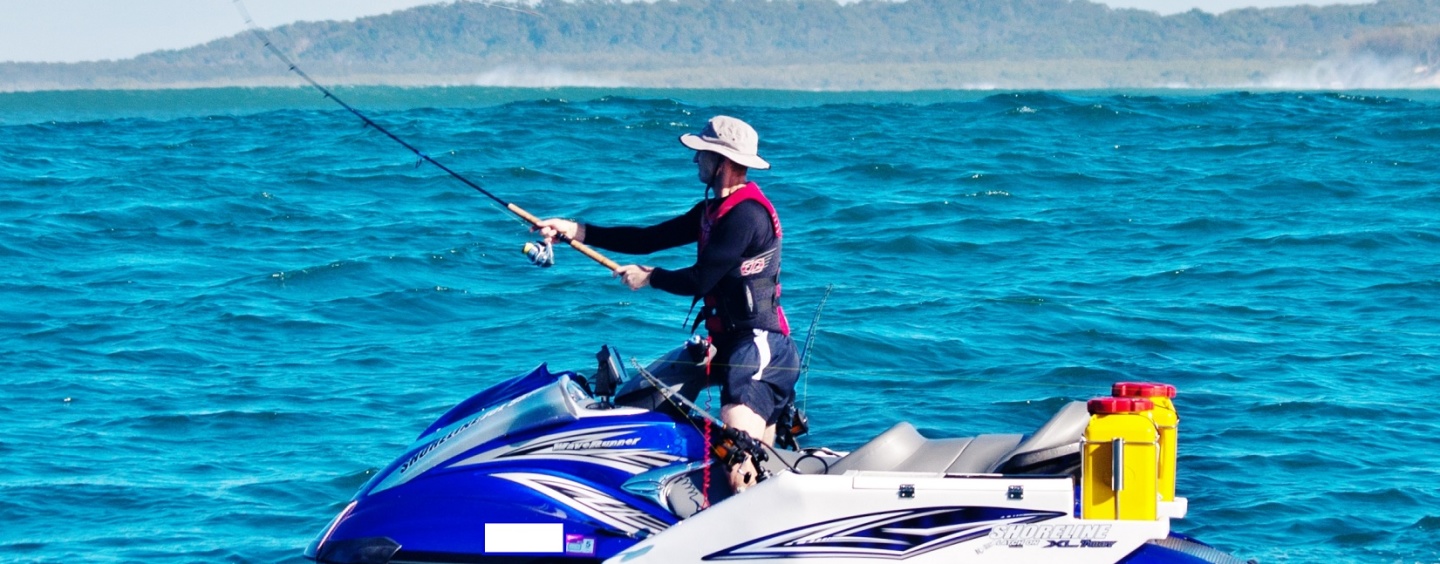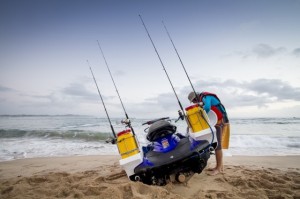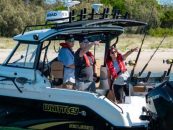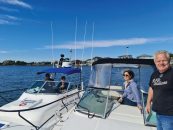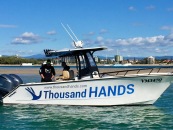Personal Water Craft (PWC) fishing is fast growing in popularity worldwide and for good reason. With an ever increasing number of PWC being sold, and the manner in which they have evolved over the years, they are much more versatile and lend themselves to more applications, one of them being fishing!
For a novice fisher, there are many reason why gearing your PWC to go fishing is a good idea. The practical reasons are that it requires no crew, launching is much easier than a boat, and the clean-up time is shorter. Once you have equipped your PWC and gained experienced, PWC fishing becomes very efficient, so much so that if you have an hour free in your day, you can always go fishing. Further, the agility and speed at which the PWC can travel dramatically reduces travel time to fishing locations with more time to fish.
For the experienced fisher, the PWC offers access to waterways where many boats cannot easily go. Out on the PWC, you are very close to the waterline and open to nature. When you do hook a fish, your bent rod tip will most likely be beneath the water’s surface making for some exciting action. While lending itself to some great photo opportunities, being so close to water can create some intimidating situations when you land a serious-size fish.
There are many factors that make a PWC a successful fishing craft. The turbulence and noise in the water while trawling is minimal because the propeller, which is in a housing (impeller), and the exhaust are only a foot below the water’s surface, whereas with an outboard motor, the propeller and exhaust are at least a metre below the water’s surface.
Additionally, a PWC is very easy to manoeuvre in and out of the surf which makes fishing offshore a pleasure. Technically, once a large fish has been hooked, retrieval is made easy. Being light in the water, the PWC is pulled around by the fish while reeling in, and eventually the fish and craft meet half way. Once the fish is close, there is no need to worry about your line getting caught on props or outboard motor “legs”.
Equipment
You will need a suitable PWC preferably a 3-seater with a 4-stroke engine such as the Yamaha FX high output which is renowned for its reliability, stability and ease of use. The PWC can be fitted with rod holders, tubby storage units or an ice box. The Tubby’s and ice box are easily removed in the event that you and the family wish to use your PWC for a normal recreational ride. Ideally, the PWC should be coupled with a trailer that can be launched and retrieve in tidal areas on sand that is fitted with an appropriate-size winch and pivoting rollers.
You will require rods, reels, soft bait, slow jigs and trolling lures, gaff, kill-stick, spearfishing stringer, a pair of protective shoes or booties, and of course, a lifejacket. The rod is your own choice, some preferring a stiff rod. Experts recommend that you take just two or three rods so that your fishing access is not complicated with tackle and you can manoeuvre around without being obstructed. You will need an active work space to continually cast and retrieve your baits. If the fish are not biting, then try different colours, sizes and types of baits.
The government-required safety equipment for a PWC when on smooth waters is a torch and capacity label. Additionally, required on partially smooth waters are a V-sheet and flare kit. Further out, beyond the partially smooth waters and more than two nautical miles from land, an EPIRB (406MHz) is compulsory. Also, take your mobile phone and the phone numbers of your local volunteer marine rescuers. If you intend to be out after dark, then navigations lights are essential.
Game fish on a PWC
When targeting game fish, your best success will be by trolling lures. Try a Rapalas CD 14 MAG, trolled at a speed of 16kmh to 20kmh, and a distance of approximately 100 metres behind the PWC. Just as successful is a Williamson lure (such as Exciter Bird, kingfish jig, Octopus Squid, popper plug, Bait-O-Matic) or a Cuda Duster being trolled at 4kmh to 8kmh and a distance of roughly 30 metres behind the PWC. Once the fish is on the PWC use a spearfishing stringer which is fed through the fish’s gills and tie to the PWC. The fish are kept in the foot wells of the PWC, and on a 3-seater, there is enough space to hold about 40kgs to 50kgs of fish.
PWC Fish Finder and GPS
To locate fish, it is recommended that a Fish Finder/GPS is fitted. If you want great value for money, look no further than the Garmin Echo Map series. These well priced units are very user friendly, reliable and also come preloaded with all mapping and detail for Australia. The head unit should be mounted in a suitable position where the screen is in your line of sight, such as up top near the gauge. This is important for maintaining direction while on the trawl
A double battery system is also highly recommended for added safety and peace of mind. Although the sounder draws very little power while turned on, running the two batteries parallel can also come in handy especially when restarting the jet ski, the starter motor can draw so much amperage, that with one battery often the sounder dips off before you get a chance to save your marks.
Most riders are looking to join like-minded people for PWC social events. Beyond PWC trekking together, riders are now joining one another for a fishing adventure and finding great enjoyment and success doing so. Here on the Gold Coast, an increasing numbers of PWC’s are being used for fishing on the Broadwater, out at sea, and on the rivers and canals. You can find groups online or by asking your local PWC and fishing tackle agents.
By Jake Van Zyl and Jordan O’Keeffe
Interview with Andy Kancachian






















